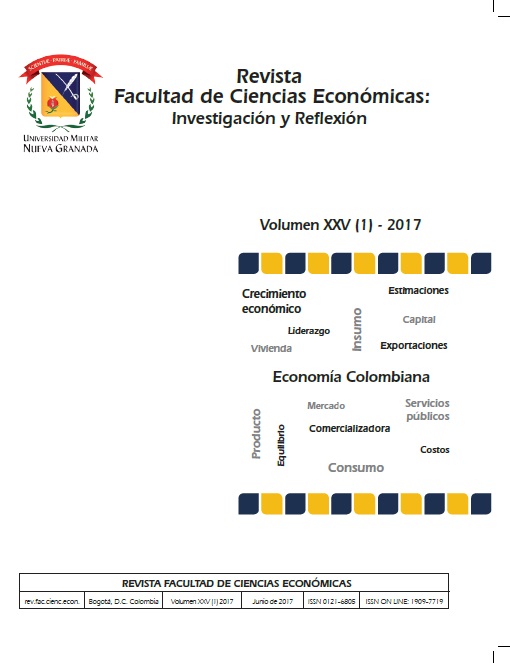A financial approach to the apparel international trading companies´ export potential through a stochastic dupont
Abstract
This paper quantifies the impact of efficiency, profit margin and financial leverage on the export performance of apparel international trading companies, using a stochastic Dupont analysis. Primarily a Monte Carlo simulation is used to model the Dupont system, bringing all figures in the balance sheet and the income statement to the probability distributions of best fit, producing a figure to explain the performance of the equity and investment for these type of businesses. Then, through a sensitivity analysis, using @ Risk, the impact of the explanatory variables (efficiency, margin and leverage) in the behavior of the Dupont projected index is determined. It is that companies in the study have a clear financial weakness, and that the sector shows low efficiency in the use of resources.Downloads
References
Bernstein, L. & Wild, J. (1998). Financial Statement Analysis: Theory, Application, and Interpretation. Boston: Irwin McGraw-Hill.
Blumenthal, R. (1998). Tis the gift to be simple: Why the 80-year-old DuPont model still has fans. CFO Magazine, 1-3.
Botika, M. (2012). The use of DuPont Analysis in Abnormal Returns Evaluation: Empirical Study of Romanian Market. Procedia - Social and Behavioral Sciences, 62, 1179-1183. https://doi.org/10.1016/j.sbspro.2012.09.202
Burja, V. & Mărginean, R. (2014). The Study of Factors that may Influence the Performance by the Dupont Analysis in the Furniture Industry. Procedia Economics and Finance, 16, 213-223. https://doi.org/10.1016/S2212-5671(14)00794-1
Chang, K., Chichernea, D. & HassabElnaby, H. (2014). On the DuPont analysis in the health care industry. Journal of Accounting and Public Policy, 33(1), 83-103. https://doi.org/10.1016/j.jaccpubpol.2013.10.002
Collier, H., McGowan Jr, C. & Muhammad, J. (2010). Evaluating the impact of a rapidly changing economic environment on bank financial performance using the Dupont system of financial analysis. Asia Pacific Journal of Finance and Banking Research, 4(4), 25-35.
Cuevas, C. (2001). Medición del desempe-o: retorno sobre inversión, ROI; ingreso residual, IR; valor económico agregado, EVA; análisis comparado. Estudios Gerenciales, 17(79), 13-22.
Dehning, B. & Stratopoulos, T. (2002). DuPont analysis of an IT-enabled competitive advantage. International Journal of Accounting Information Systems, 3(3), 165-176. https://doi.org/10.1016/S1467-0895(02)00032-5
Fairfield, P. & Yohn, T. (2001). Using asset turnover and profit margin to forecast changes in profitability. Review of Accounting Studies, 6(4), 371-385. https://doi.org/10.1023/A:1012430513430
García, O. (2011). Administración Financiera: Fundamentos y Aplicaciones. Cali: Prima Moderna.
Hubbard, D. (2009). Failure of Risk Management: Why its Broken and How to Fix it. New Jersey: John Wiley & Sons.
León, R. & Martínez, E. (2008). Aplicación del modelo Dupont a la información financiera generada por el simulador de negocios 2008. Tesis de Grado, Puebla: Universidad de las Américas Puebla, Departamento de Finanzas y Contaduría.
Monterrey, J. & Sánchez-Segura, A. (2011). Persistencia y capacidad predictiva de márgenes y rotaciones. Un análisis empírico. Revista de Contabilidad, 14(1), 121-153. https://doi.org/10.1016/S1138-4891(11)70024-3
Nissim, D. & Penman, S. (2001). Ratio analysis and equity valuation: From research to practice. Review of accounting studies, 6(1), 109-154. https://doi.org/10.1023/A:1011338221623
Restrepo, J. & Vanegas, J. (2009). Análisis del Perfil Financiero de las Pymes del Valle del Aburra y su Acceso al Crédito: Una Aproximación Empírica. Ingeniería Industrial. Actualidad y Nuevas Tendencias, (3), 43-54.
Restrepo, J. & Vanegas, J. (2014). Desempe-o exportador del sector industrial en Colombia: análisis de frontera eficiente. Criterio Libre, 12(21), 140-156.
Revsine, L., Collins, D. & Johnson, W. (2005). Financial reporting and analysis. New York, NY: Pearson/Prentice Hall.
Shafer, S., Smith, H., & Linder, J. (2005). The power of business models. Business Horizons, 48(3), 199-207. https://doi.org/10.1016/j.bushor.2004.10.014
Soares, E. & Galdi, F. (2011). Relação dos modelos DuPont com o retorno das ações. Revista Contabilidade & Finanças, 22(57), 279-298. https://doi.org/10.1590/S1519-70772011000300004
Stancu, I., Stancu, D. & Oproiu, A. (2013). Studiu empiric privind factorii determinaţi ai performanţei financiare a întreprinderii - Sistemul DuPont. Audit Financiar, 11(103), 24-35.
Stickney, C. & Brown, P. (1999). Financial reporting and statement analysis: A strategic perspective. New York: Dryden Press.
Van Voorhis, K. (1981). The Dupont model revisited a simplified application to small business. Journal of Small Business Management, 19(2), 45-51.
Vargas, J., Barrett, M. & Cordero, J. (2013). Finanzas modelos para la prevención de bancarrotas empresariales utilizados por el sector empresarial costarricense. Tec Empresarial, 7(3), 43-49. https://doi.org/10.18845/te.v7i3.1575











